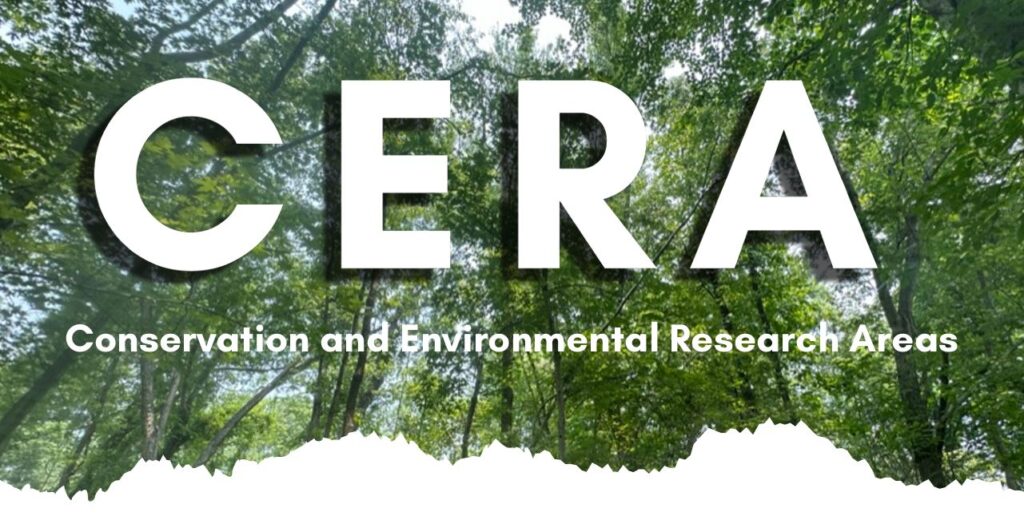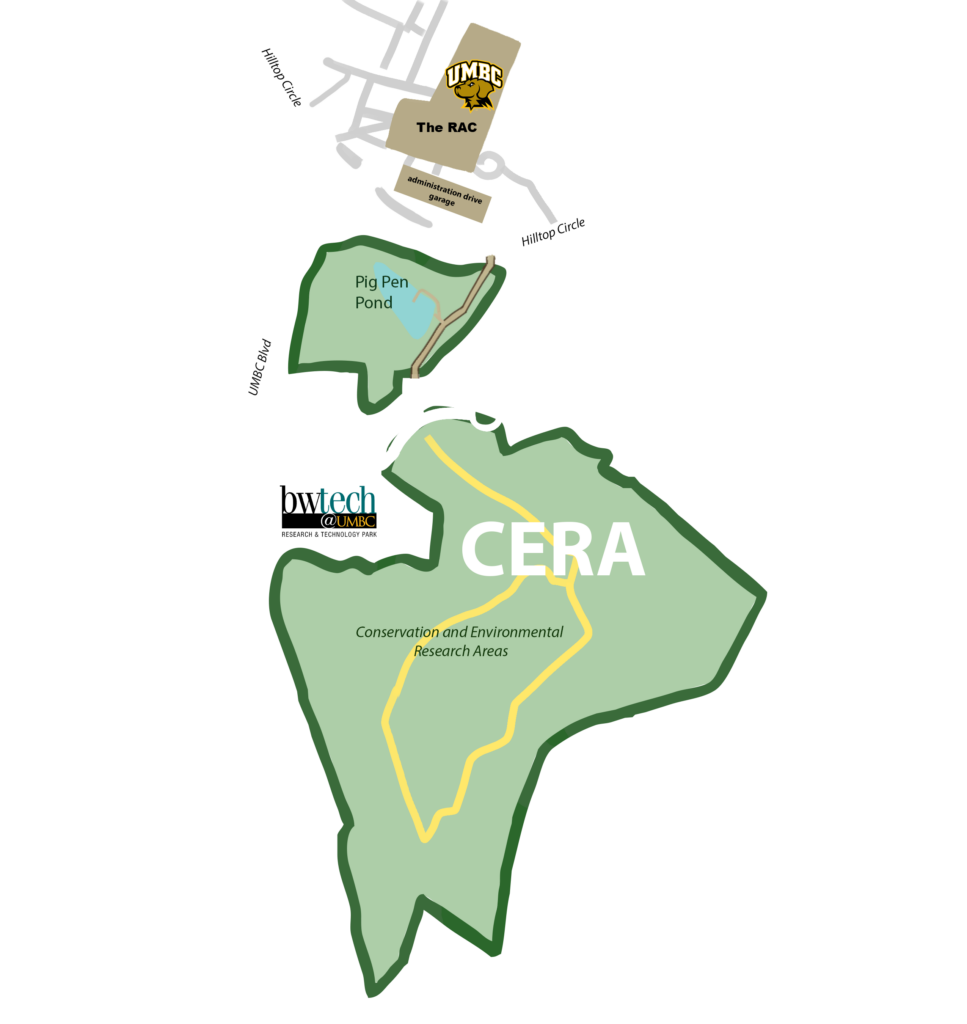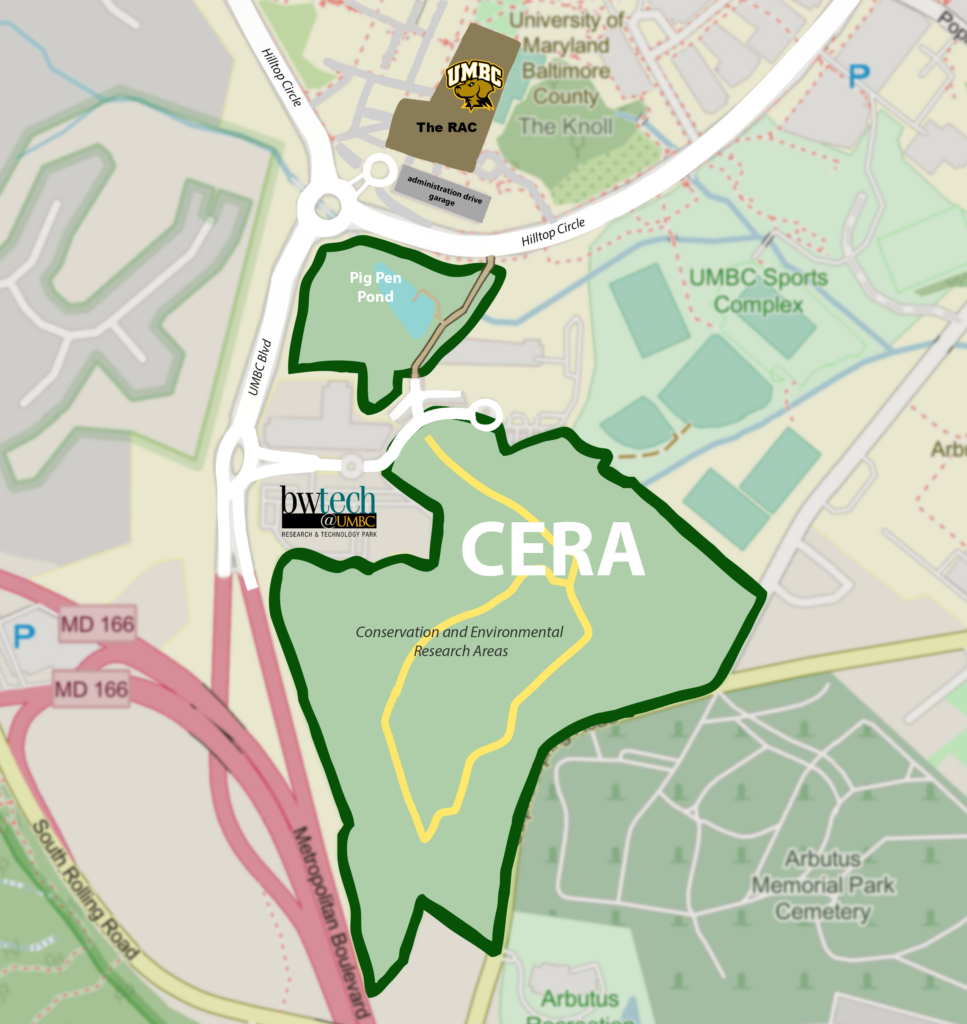What is CERA?
The Conservation & Environmental Research Area, also known as “CERA”, refers to two protected areas on campus that add up to about 50 acres. CERA was established to support environmental education, conservation, and research on the UMBC campus.
Download the CERA Introduction Flier
History
Plans were announced in the early 1990’s to build a research park on top of a large, forested area in the south-west corner of campus. After extensive faculty and student organizing and advocacy efforts over multiple years, which included support from the wider community, it was decided that the research park only needed half the acreage originally designated for the development.
As part of organizing and advocacy, faculty offered an alternative proposal for how UMBC should use the land. They proposed that UMBC designate the land for teaching and research. This proposal was adopted for the remaining undeveloped acres, removed from the final research park design, and the land was designated as a protected academic landscape. Today this area is referred to as “CERA”.
During the dedication speech on Earth Day, April 22, 1997, former UMBC President Freeman Hrabowski stated that the Conservation and Environmental Research Area (CERA) was being protected as a campus resource “to further our understanding and appreciation of this natural landscape.”
Within CERA there are several sites of cultural and historical significance. UMBC faculty led archaeological excavations, staffed by students, between 1970 – 1973 that documented many of these sites*.
The content in this section includes information shared by previous and current UMBC faculty (who were involved in or currently support CERA) and read in documents from the AOK Library Special Collections.
*In the university Land Acknowledgement, UMBC states the campus was established upon the land of the Piscataway and Susquehannock peoples. Over time, citizens of many more Indigenous nations have come to reside in this region. The university offers respect to all past, present, and future Indigenous people connected to the land the campus resides upon.
Extent
At present, CERA covers about 50 acres of the UMBC landscape, and is located in two different areas. The larger tract, covering approximately 45 acres of the south end of the main campus, is comprised of a wide variety of ecological conditions: mature upland forest, early- and mid- successional forest, and riparian and wetland environments. The second, and much smaller CERA area, surrounds Pig Pen Pond.
Uses
All of CERA is open for exploration by the UMBC community and campus visitors. Community members and visitors are invited to immerse themselves in the beauty of CERA and the tranquil nature of this special natural area.
Since its dedication, CERA has also been used for a variety of undergraduate research projects, visited by a number of classes, and has been the focus of class projects. Faculty, staff, students, and other community members desiring further information or who wish to utilize CERA for events, research, or teaching are encouraged to contact the CERA Steering Committee (cera@umbc.edu).
Learn more about…
Visiting CERA
Why visit, when to visit, safety in CERA, area map, and other resources.
Exploring the Trail
Interpretative trail map, link to interpretive post information, and download trail guide.
Research in CERA
How CERA has been used for research, in the past and currently.
CERA Steering Committee
The UMBC Conservation and Environmental Research Area (CERA) Steering Committee was established after the dedication of CERA in 1997. The purpose of the committee is to “advance UMBC’s mission of environmental stewardship within a designated educational and research landscape” (as stated in the committee bylaws). Committee members represent faculty, staff, and students that care about CERA and members meet 3-5 times during the academic year.
Responsibilities of the CERA committee include:
- To manage and maintain CERA as natural areas, to be preserved and protected for approved uses in education, research, and wildlife observation;
- To promote environmental education opportunities for UMBC students and faculty within CERA (as a academic landscape);
- To promote short and long range research projects in a variety of disciplines relevant to CERA;
- To promote a wider appreciation and scientific understanding of CERA through teaching, scholarly publication, newsletters, and public lectures;
- To cooperate with other UMBC committees, offices, departments, programs, and centers having similar and compatible purposes;
- To solicit and expend funds necessary to carry out the above-stated purposes.
Interested in learning more about CERA or use of the areas for research and other activities? The CERA Steering Committee can be reached at cera@umbc.edu.
CERA Steering Committee Portal
CERA Steering Committee files are accessible to all active committee members through the committee portal.


